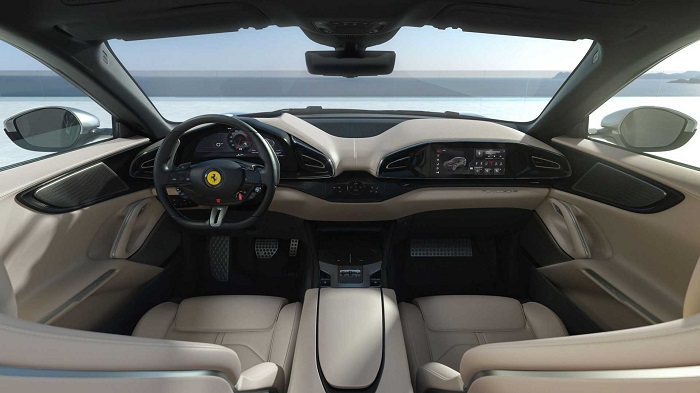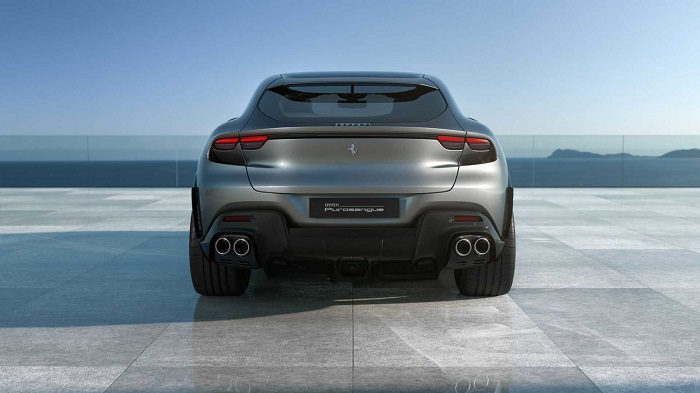With so much glee from luxury car owners and performance car enthusiasts greeting the announcement of Ferrari’s first-ever 4-door controversial vehicle, the buzz is guaranteed to linger, not for a little while.
The Ferrari Purosangue is the Prancing Horse’s first ever four-door, four-seater in its 75-year history and was unveiled a few days ago at Maranello in Italy, the city of seduction, art and indulgence, precisely at the magnificently atmospheric surroundings of the Teatro del Silenzio in Lajatico (Pisa), in an atmosphere of tranquil ambience, akin to sacred ceremonies.
No sooner was the car – an undeniable convergence of finest art and science unveiled, that its controversial and record-setting attributes came tumbling out, from its name to the argument that it isn’t an SUV despite looking like one, to the monstrous powertrain under its hood and then its unavoidable comparison to the Lamborghini Urus SUV – (a class leader in the category?).
What’s in the name?
Purosangue is Italian for ‘thoroughbred’ or bloodline, the first syllable is pronounced as ‘pure’ and it was chosen to reflect the sports DNA of all Ferraris, this being no exception.
Is the Purosangue an SUV?
Despite the company’s overboard efforts to distinguish or alienate the Purosangue from other SUVs and create a new nomenclature for it, most renowned car pundits in their reviews believe the attempt is nothing short of semantics and doesn’t erode practical reality, as Edmunds summed it up: “Ferrari calls the new Purosangue a “four-door sports car.” Does that make it an Italian Nissan Maxima? Nope. Instead, the Prancing Horse is refraining from calling the Purosangue what it actually is. With four doors, four seats, a tall driving position, the biggest cargo area of any Ferrari history, all-wheel drive and hill descent control, what else could the Purosangue be but an SUV?”
This is the first time a four-door model with four fully sized seats has made production, but Ferrari refuses to describe the Purosangue as an SUV, in explaining the Ferrari Purosangue’s exterior and proportions, the makers said that it has “a completely different layout and innovative proportions compared to modern GT archetypes (so-called crossovers and SUVs).”
Phenomenal Powertrain
The Purosangue’s engine (code-named F140IA) maintains the architecture that makes the Prancing Horse’s most recent 12-cylinders (V12) so successful. Performance specs are phenomenal as it goes from 0-62 mph in only 3.3 seconds, while 0-124 takes 10.6.
Radical Innovations
Chassis – The Purosangue’s chassis is completely new and was designed from scratch with the aim of producing a structure of uncompromising rigidity. The chassis is lighter than Ferrari’s previous four-seaters despite being larger.
Roof – The single-shell carbon-fibre roof with integrated soundproofing is completely new and delivers rigidity levels on par with a glass roof while weighing 20% less than an aluminium roof with soundproofing.
Airflow Wiper – The Purosangue doesn’t have a rear windscreen wiper, so the rear screen is cleaned by the airflow along the glass surfaces at the rear.
Headlights – The unconventional location of the headlights made it possible to create two air intakes above and below the daytime running light (DRL). The upper one is used to channel air into the complex blown system which vents underneath the front aerobridge. The lower one, on the other hand, is used to channel air to the brake cooling system.
Environmental Sustainability – Climate enthusiasts will hopefully have no grouse with this piece of engineering, as Ferrari’s pursuit of luxury did not distract it for a second from its environmental and sustainability responsibilities. Sustainable materials have been used extensively throughout the Purosangue, opening up the possibility for new combinations. In fact, 85% of the launch trim for the car was sustainably produced: the fabric roof-lining is recycled polyester, the carpet is made from polyamide recycled from fishing nets retrieved from the oceans and newly formulated Alcantara®, also derived from recycled polyester. In fact, the Purosangue is the very first car in the world to use this special version of Alcantara® made of 68% of post-consumer recycled polyester.
Audio output – The Burmester® 3D High-End Surround Sound System also makes its debut in a Ferrari vehicle as standard equipment. This audio system delivers ultimate performance from low to high frequencies, achieved by innovative technologies. The ribbon tweeter makes its first appearance in any production car, and the subwoofer is housed in its own closed cabinet for ultimate bass clarity, power and speed combined with breathtakingly low frequencies to produce 3D sound.
Colours – Among the launch colours, Nero Purosangue was developed specifically for this car using pigments that, in certain lighting conditions, create very intense red reflections that beautifully enhance the car’s volumes.
Creature comfort – The massaging front seats feature 10 airbags that deliver a relaxing, targeted massage with a choice of five different types of massage and three levels of intensity.
Maintenance for the money
Ferrari is offering an extended seven-year maintenance programme with the Purosangue. Available across the entire range, the latter covers all regular maintenance for the first seven years of the car’s life.
A collectors’ Item – To further alienate itself from the likes of Lamborghini, Porsche, Roll Royce and Bentley SUVS, which were used to drive up sales by these iconic carmakers, the supercar-maker says Purosangue sales will be restricted to no more than 20% of Ferrari’s total annual volume. So, expect in the region of 2000 Purosangues to be built a year.
Price – The car will first hit U.S. auto dealership in the fourth quarter of next year and is expected to be pricier than all its rivals. The Lamborghini Urus Performante will cost only $260,676, while the Aston Martin DBX707 starts from $236,000. The most expensive Porsche Cayenne, the Turbo GT, starts at $188,700. But what none of these SUVs has is a V12, estimates suggest that it will cost in the region of $400,000 MSRP, which is N171,324,000.00, at 428 naira to a dollar (official rate), while freight, duty and other clearing charges could gross an additional N85,0000 bringing the total cost to around N250,000,000.
What experts think about the Purosangue
Motortrend: On Ferrari’s current form, the Purosangue should have engineers at Aston Martin, Lamborghini, and Bentley worried. It promises to be a benchmark car.
Vehicle Virgins: Foldable backseats to accommodate more cargo makes it a ‘practical Ferrari’, on performance, it kills the URUS and it’s the craziest rare SUV ever made, because of Ferrari’s decision to limit production to 20%.
Evo: It beats the URUS. it’s a cool-looking thing but won’t set many hearts fluttering, say in the style of its own 296 GTB sports car, but it’s a Ferrari and an SUV which is weird. It also feels a step up from the supercars in terms of quality and luxury – a different approach to suit the new expectations of its customers.
Car and Driver: An SUV with Ferrari’s prancing horse badge on the grille won’t ruin the brand, though. After all, successful iterations of the concept have served sports-car brands such as Porsche and Lamborghini quite well. Expect to need a hedge-fund manager’s salary to afford it.
Car Buzz: While we’re not convinced that the Purosangue isn’t – at the very least – a high-performance crossover, Ferrari has certainly created a vehicle that is unique in this segment. At the end of the day, whatever it’s classified as hardly matters – this is an arresting and interesting visual extension of the Ferrari brand, and that’s a win in our book.
Top Gear: Where a Urus is all creases, this is smoother and more graceful. With the Purosangue, the designers did eventually finish it. With the Urus, you sense they were still denting and folding it as it headed down the production line. it’s also undoubtedly the most exotic SUV engine installation of all time. But the view out is by no means tall and commanding. It’s like being in an overgrown family estate. One that happens to keep up with a Ferrari Enzo.
Edmunds: New Purosangue is the most family-friendly Ferrari ever made. Potential buyers will likely cross-shop the Purosangue with the Lamborghini Urus, with a reported price tag of about $400,000, the Ferrari costs almost double the standard version of the Lamborghini. The Purosangue is smaller in every dimension, lighter in weight, and faster in a straight line. The Ferrari’s curvaceous bodywork stands in sharp contrast to the angrily angular Lambo.




















